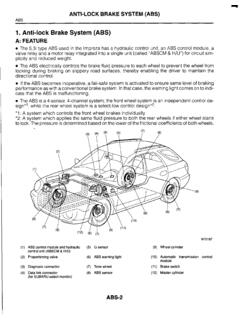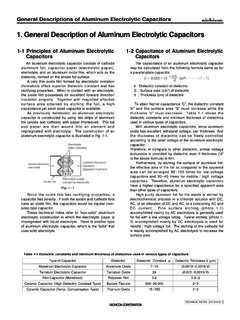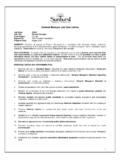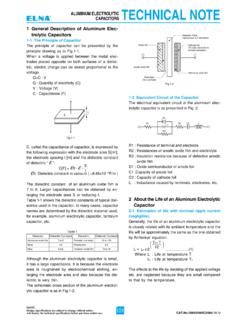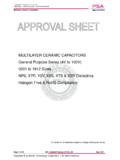Transcription of 1. General Description - ken-gilbert.com
1 1. General DescriptionA: WIRING DIAGRAMThe wiring diagram of each system is illustrated sothat you can understand the path through whichthe electric current flows from the and codes are used in the should read as follows:IEach connector and its terminal position areindicated by a sketch of the connector in a discon-nected state which is viewed from the number of poles or pins, presence of a lock, and pin number of each terminal are indicated in thesketch of each connector. In the sketch, the highest pole number refers to the number of poles which theconnector has. For example, the sketch of the connector shown in figure indicates the connector has used in vehicleConnector shown in wiring diagramSketchSymbolNumber of polesG6M0194G6M0196G6M0198 Numbered in order from upperright to lower in order from upperleft to lower [D1A0]WIRING DIAGRAM1. General DescriptionIWhen one set of connectors is viewed from thefront side, the pole numbers of one connector aresymmetrical to those of the other.
2 When these twoconnectors are connected as a unit, the poleswhich have the same number are wiring harness:The connectors are numbered along with the num-ber of poles, external colors, and mating connec-tions in the accompanying sketch of each connector in the wiring dia-gram usually shows the (A) side of the relationship between the wire color, terminalnumber and connector is described in :A wire which runs in one direction from a connec-tor terminal sometimes may have a different colorfrom that which runs in the other direction from wiring diagram, connectors which have no ter-minal number refer to one-pole types. Sketches ofthese connectors are omitted following color codes are used to indicatethe colors of the wires codeColorLBlueBBlackYYellowGGreenRRedWWh iteBrBrownLgLight greenGrGrayPPinkOrOrangeLbLight BlueVVioletSASealed (Inner)SBSealed (Outer)G6M02013[D1A0]6-3 WIRING DIAGRAM1.
3 General DescriptionIThe wire color code, which consists of two let-ters (or three letters including Br or Lg), indicatesthe standard color (base color of the wire covering)by its first letter and the stripe marking by its sec-ond table lists the nominal sectional areas andallowable currents of the :IWhen replacing or repairing a wire, be sureto use the same size and type of the wire whichwas originally :IThe allowable current in the table indicates thetolerable amperage of each wire at an ambienttemperature of 40 C (104 F).IThe allowable current changes with ambienttemperature. Also, it changes if a bundle of morethan two wires is sec-tional areamm2No. ofstrands/strand diam-eterOutsidediameter offinished wir-ingmmAllowablecurrentAmps/40 (or ) (or ) (or ) (or )21226 (or )28341 (or )38565 (or )51850 unit is directly grounded to the body orindirectly grounds through a harness ground termi-nal.
4 Different symbols are used in the wiring dia-gram to identify the two grounding ground points shown in the wiring diagramrefer to the following:NOTE:All wiring harnesses are provided with a groundpoint which should be securely [D1A0]WIRING DIAGRAM1. General DescriptionIRelays are classified as normally-open or normally-closed. The normally-closed relay has one or wiring diagram shows the relay mode when the energizing circuit is [D1A0]6-3 WIRING DIAGRAM1. General DescriptionIEach connector number shown in the wiring dia-gram corresponds to that in the wiring location of each connector in the actualvehicle is determined by reading the first characterof the connector (for example, a F for F8, i fori16, etc.) and the type of wiring first character of each connector numberrefers to the area or system of the harness and cordFFront wiring harnessBBulkhead wiring harnessEEngine wiring harness,Oxygen sensor cordTTransmission cordDDoor cord LH & RH,Rear door cord LH & RHiInstrument panel wiring harnessRRear wiring harness,Rear defogger cord (Ground)Fuel tank cord,Roof cord,Rear gate cord,Rear gate lock adapter cordG6M02052.
5 Basic Diagnostics ProcedureA: BASIC PROCEDURE1. GENERALThe most important purpose of diagnostics is todetermine which part is malfunctioning quickly, tosave time and IDENTIFICATION OF TROUBLESYMPTOMD etermine what the problem is based on the PROBABLE CAUSE OF TROUBLELook at the wiring diagram and check the system scircuit. Then check the switch, relay, fuse, ground, LOCATION AND REPAIR OF TROUBLE1) Using the diagnostics narrow down the ) If necessary, use a voltmeter, ohmmeter, ) Before replacing certain component parts(switch, relay, etc.), check the power supply,ground, for open wiring harness, poor connectors,etc. If no problems are encountered, check thecomponent CONFIRMATION OF SYSTEMOPERATIONA fter repairing, ensure that the system : INSPECTION1. VOLTAGE MEASUREMENT1) Using a voltmeter, connect the negative lead toa good ground point or negative battery terminaland the positive lead to the connector or compo-nent ) Contact the positive probe of the voltmeter onconnector (A).
6 The voltmeter will indicate a ) Shift the positive probe to connector (B). Thevoltmeter will indicate no [D2A1]WIRING DIAGRAM2. Basic Diagnostics Procedure4) With test set-up held as it is, turn switch voltmeter will indicate a voltage and, at thesame time, the light will come ) The circuit is in good order. If a problem suchas a lamp failing to light occurs, use the proce-dures outlined above to track down the CIRCUIT CONTINUITY CHECKS1) Disconnect the battery terminal or connector sothere is no voltage between the check the two leads of an ohmmeter to each ofthe check the circuit has diodes, reverse the two leads andcheck ) Use an ohmmeter to check for diode contacting the negative lead to the diodepositive side and the positive lead to the negativeside, there should be contacting the two leads in reverse, thereshould be no ) Symbol q q indicates that continuity existsbetween two points or terminals.
7 For example,when a switch position is 3 , continuity existsamong terminals 1, 3 and 6, as shown in HOW TO DETERMINE AN OPENCIRCUIT1) Voltmeter Method:An open circuit is determined by measuring thevoltage between respective connectors andground using a voltmeter, starting with the connec-tor closest to the power supply. The power supplymust be turned ON so that current flows in the cir-cuit. If voltage is not present between a particularconnector and ground, the circuit between thatconnector and the previous connector is ) Ohmmeter method:Disconnect all connectors affected, and check con-tinuity in the wiring between adjacent the ohmmeter indicates infinite , the wiringis [D2B3]6-3 WIRING DIAGRAM2. Basic Diagnostics Procedure4. HOW TO DETERMINE ASHORTCIRCUIT1) Test lamp method:Connect a test lamp (rated at approximately 3watts) in place of the blown fuse and allow currentto flow through the circuit.
8 Disconnect one connec-tor at a time from the circuit, starting with the onelocated farthest from the power supply. If the testlamp goes out when a connector is disconnected,the wiring between that connection and the nextconnector (farther from the power supply) ) Ohmmeter method:Disconnect all affected connectors, and check con-tinuity between each connector and ground. Whenohmmeter indicates continuity between a particularconnector and ground, that connector is Working PrecautionsA: PRECAUTIONS WHEN WORKINGWITH THE PARTS MOUNTED ONTHE VEHICLE1) When working under a vehicle which is jacked-up, always be sure to use safety ) The parking brake must always be applied dur-ing working. Also, in automatic transmissionvehicles, keep the select lever set to the P (Park-ing) ) Be sure the workshop is properly ventilatedwhen running the engine. Further, be careful not totouch the belt or fan while the engine is ) Be careful not to touch hot metal parts, espe-cially the radiator and exhaust system immediatelyafter the engine has been shut : PRECAUTIONS IN TROUBLEDIAGNOSIS AND REPAIR OFELECTRIC PARTS1) The battery cable must be disconnected fromthe battery s ( ) terminal, and the ignition switchmust be set to the OFF position, unless otherwiserequired by the ) Securely fasten the wiring harness with clampsand slips so that the harness does not interferewith the body end parts or edges and bolts ) When installing parts, be careful not to catchthem on the wiring ) When disconnecting a connector, do not pullthe wires, but pull while holding the [D2B4]WIRING DIAGRAM3.
9 Working Precautions5) Some connectors are provided with a lock. Onetype of such a connector is disconnected by push-ing the lock, and the other, by moving the lock either type the lock shape must be identifiedbefore attempting to disconnect the connect, insert the connector until it snaps andconfirm that it is tightly ) When checking continuity between connectorterminals, or measuring voltage across the termi-nal and ground, always contact tester probe(s) onterminals from the wiring connection side. If theprobe is too thick to gain access to the terminal,use mini test check water-proof connectors (which are notaccessible from the wiring side), contact testprobes on the terminal side being careful not tobend or damage the ) Sensors, relays, electrical unit, etc., are sensi-tive to strong them with care so that they are not droppedor [D3B0]6-3 WIRING DIAGRAM3.
10 Working Precautions4. How to Use Wiring DiagramH6M0796AA: RELAYA symbol used to indicate a : CONNECTOR-1 The sketch of the connector indicates the : WIRING CONNECTIONSome wiring diagrams are indicated in foldouts forconvenience. Wiring destinations are indicatedwhere necessary by corresponding symbols (aswhen two pages are needed for clear indication).D: FUSE No. & RATINGThe FUSE No. & RATING corresponds with thatused in the fuse box (main fuse box, fuse and jointbox).E: CONNECTOR-2 IEach connector is indicated by a terminal number is indicated in the corre-sponding wiring diagram in an abbreviated example, terminal number C2 refers to terminal of connector (C: F41) shown in the con-nector [D400]WIRING DIAGRAM4. How to Use Wiring DiagramF: CONNECTOR SKETCHIEach connector sketch clearly identifies theshape and color of a connector as well as terminallocations.
